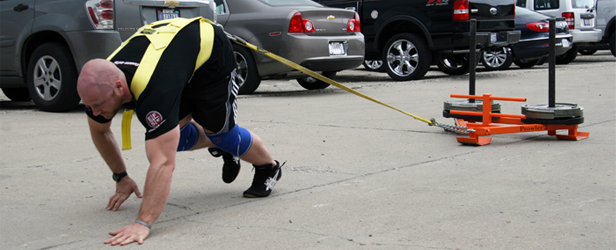
Many athletes and coaches make use of sled towing as a training intervention. Some use the sled as a substitute or a supplement to conventional resistance training in order to increase the dynamic correspondence of the exercise to athletic movements such as running and sprinting. Others use the sled for conditioning, or for developing the lower body without involving a significant eccentric component to the exercise, which reduces soreness and reduces the chances of overtraining.
Two common attachment points when towing the sled are:
- The straps over the shoulders
- The straps attached to the waist
Recently, a study1 was published in Sports Medicine which investigated the various lower body moment impulses to help us determine whether sled towing was primarily a knee-dominant (i.e., worked more quadriceps than hip extensors) or a hip-dominant (i.e., worked more hamstrings and gluteals than quadriceps) movement and to examine whether the placement of the straps affected how the exercise worked the lower body muscles.
What did the researchers do?
The researchers wanted to establish what happened to lower limb joint moments when sleds were towed using two different attachment points: at the waist and at the shoulder. So they recruited 12 healthy, physically active college-aged subjects (eight males and four females). The subjects performed sled-towing trials with 50% of bodyweight using an elitefts™ dragging sled at 1.3m/s with the sled attached at the waist and at the shoulder. They also performed a trial in which they walked without a sled for comparison purposes.
What happened?
The waist-height attachment
The researchers found that the waist-height attachment displayed greater hip moment impulses than the shoulder-height attachment, as the graph below shows, where the hip moment impulses of both the dominant and non-dominant legs are significantly higher during the waist-attachment trial.
The shoulder-height attachment
The researchers found that the shoulder-height attachment displayed greater knee moment impulses than the waist attachment, as the graph below shows, where the knee moment impulses of both the dominant and non-dominant legs are significantly higher during the shoulder-attachment trial.
Ratio of hip-to-knee moment impulses
Since we have both hip and knee moment impulses, we can make an assessment of the hip- and knee-dominance of each type of sled dragging movement. The graph shows that the ratio of hip-to-knee moment impulses is less than 1.0 in the shoulder-height trial, meaning that it is a knee-dominant exercise. However, the ratio is greater than 1.0 in the waist-height trial (for the dominant leg at least), meaning that it is a hip-dominant exercise.
How do these ratios compare to squats and deadlifts?
For reference, the hip-to-knee moment ratio of the deadlift is c. 2 – 4 times2 and the ratio of the standard back squat is c. 1 – 1.5 times3. So the waist-height sled-towing exercise is slightly more hip-dominant than the standard back squat and slightly less hip-dominant than the standard deadlift. Towing the sled with a waist-height attachment will therefore likely have carryover to both lifts, depending on the lifter’s style and area of weakness.
However, the shoulder-height attachment hip-to-knee ratio is firmly sub-1.0, which means that it is only likely to assist a lifter during the squat, and probably only when that lifter is relatively weaker in the quadriceps than in the hamstrings and gluteals.
What did the researchers conclude?
The researchers concluded that attaching the load to the waist leads to greater hip extension moment impulses, while attaching the load to the shoulder leads to greater knee extension moment impulses. Therefore, using a sled to develop the hamstrings and gluteals should involve a waist-height attachment, and using the sled to develop the quadriceps should involve a shoulder-height attachment.
Wrapping up
Walking while towing a sled is probably quite effective for increasing the strength of both hip and knee muscles. However, the attachment point is critical for determining whether the sled is primarily working the hip muscles (i.e., hamstrings and gluteals) or the knee muscles (i.e., quadriceps).
Attaching the sled load to the waist leads to greater hip extension moments, while attaching the sled load to the shoulder leads to greater knee extension moments. Therefore, using a sled to develop the hamstrings and gluteals should involve a waist-height attachment, and using the sled to develop the quadriceps should involve a shoulder-height attachment.
***
References
- Lawrence, M., Hartigan, E., & Tu, C. (2012). Lower limb moments differ when towing a weighted sled with different attachment points. Sports Biomechanics, (ahead-of-print), 1-9.
- Swinton, P. A., Stewart, A., Agouris, I., Keogh, J. W., & Lloyd, R. (2011). A biomechanical analysis of straight and hexagonal barbell deadlifts using submaximal loads. The Journal of Strength & Conditioning Research, 25(7), 2000-2009.
- Bryanton, M. A., Kennedy, M. D., Carey, J. P., & Chiu, L. Z. (2012). Effect of Squat Depth and Barbell Load on Relative Muscular Effort in Squatting. The Journal of Strength & Conditioning Research.











